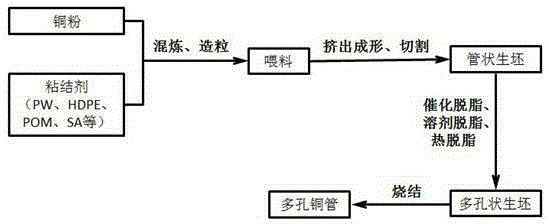Method for preparing porous heat conduction copper pipes through powder extrusion forming technology
A technology of extruding and heat-conducting copper tubes, which is applied in the field of powder metallurgy injection molding, can solve the problems of lack of porosity and difficulty in ensuring the uniform distribution of copper powder, etc., and achieve the effect of compact appearance and broad application prospects
- Summary
- Abstract
- Description
- Claims
- Application Information
AI Technical Summary
Problems solved by technology
Method used
Image
Examples
Embodiment 1
[0027] Add 45vol.% polymer binder (50wt.% paraffin, 45wt.% polyethylene and 5wt.% stearic acid) to the copper powder with a particle size D50 of 45 μm, in the internal mixer In the process, the metal powder is first heated to 160°C, and then polyethylene, paraffin and stearic acid are gradually added. After mixing evenly, the granular feed is made by a granulator. It was shaped by an extruder at 130°C to produce a tubular green body (inner diameter? 16mm, outer diameter? 20mm), and then the tubular green body was cut into a length of 300mm. Soak the green body in a n-hexane solution at 40°C and keep it warm for 24 hours to degrease the solvent. Then take out the green body, put it into the degreasing sintering furnace after drying. Pass flowing argon into the debinding sintering furnace, and remove the remaining binder by thermal debinding at 450°C. Then the temperature was gradually raised to 750°C, and the temperature was lowered after sintering for 1 hour. Finally, a po...
Embodiment 2
[0029] Add 55vol.% polymer binder (86wt.% polyoxymethylene, 6wt.% polyethylene, 6wt.% ethylene-vinyl acetate copolymer and 2wt. % stearic acid), first heat the metal powder to 180°C in an internal mixer, and then gradually add polyoxymethylene, polyethylene, ethylene-vinyl acetate copolymer and stearic acid. After mixing evenly, the granular feed is made by a granulator. It was shaped by an extruder at 175°C to produce a tubular green body (inner diameter? 10mm, outer diameter? 16mm), and then the tubular green body was cut into a length of 500mm. The green body is degreased with oxalic acid in a degreasing furnace. Then put into the degreasing sintering furnace. Pass flowing argon into the debinding sintering furnace, and remove the remaining binder by thermal debinding at 450°C. Then the temperature was gradually raised to 700°C, and the temperature was lowered after sintering for 1 hour. Finally, a porous copper tube with a porosity of 48% was obtained.
Embodiment 3
[0031] Add 50vol.% polymer binder (50wt.% paraffin, 40wt.% polyethylene and 10wt.% stearic acid) to the copper powder with a particle size D50 of 10 μm. In the process, the metal powder is first heated to 160°C, and then polyethylene, paraffin and stearic acid are gradually added. After mixing evenly, the granular feed is made by a granulator. It is shaped by an extruder at 180°C to produce a tubular green body (inner diameter? 16mm, outer diameter? 20mm), and then the tubular green body is cut into a length of 300mm. Soak the green body in a solution of n-heptane at 40°C and keep it warm for 24 hours to carry out solvent degreasing. Then take out the green body, put it into the degreasing sintering furnace after drying. Pass flowing argon into the debinding sintering furnace, and remove the remaining binder by thermal debinding at 450°C. Then the temperature was gradually raised to 750°C, and the temperature was lowered after sintering for 2 hours. Finally, a porous coppe...
PUM
| Property | Measurement | Unit |
|---|---|---|
| Particle size | aaaaa | aaaaa |
| The inside diameter of | aaaaa | aaaaa |
Abstract
Description
Claims
Application Information
 Login to View More
Login to View More - R&D
- Intellectual Property
- Life Sciences
- Materials
- Tech Scout
- Unparalleled Data Quality
- Higher Quality Content
- 60% Fewer Hallucinations
Browse by: Latest US Patents, China's latest patents, Technical Efficacy Thesaurus, Application Domain, Technology Topic, Popular Technical Reports.
© 2025 PatSnap. All rights reserved.Legal|Privacy policy|Modern Slavery Act Transparency Statement|Sitemap|About US| Contact US: help@patsnap.com

